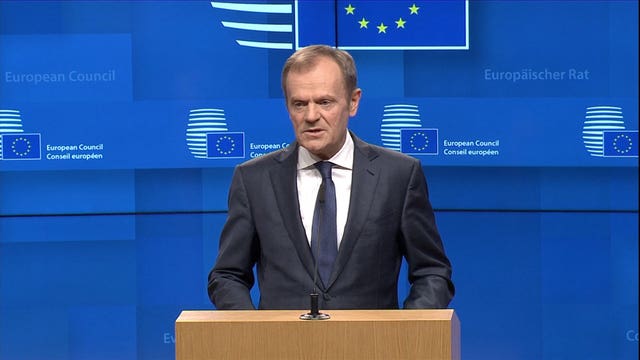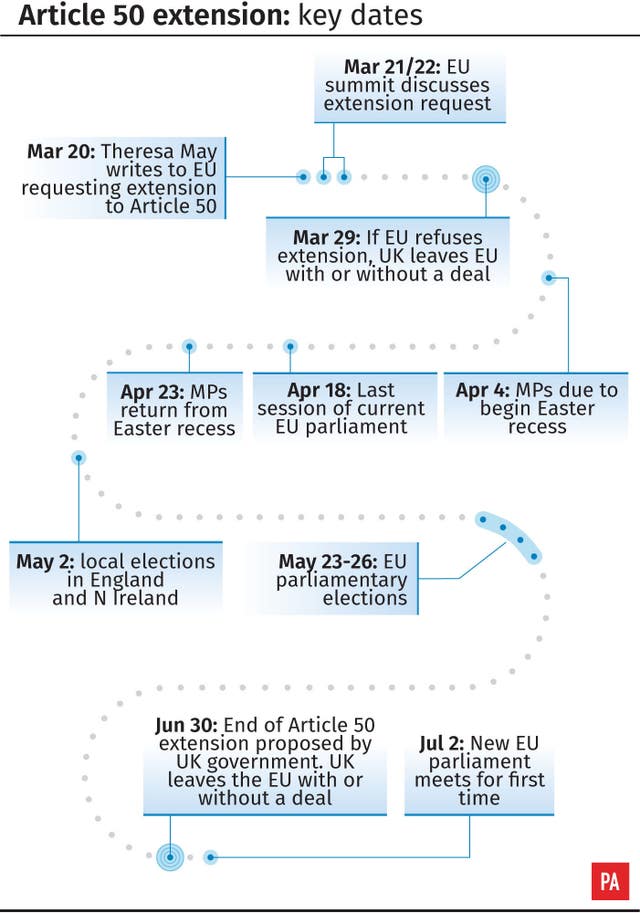
What happens next after Theresa May’s letter requesting a delay to Brexit?
Thursday March 21
Mrs May will travel to Brussels for a summit of the European Council, where she will make her case for a three-month extension to the two-year Article 50 negotiation process, putting Brexit back from March 29 to June 30.
The Prime Minister is expected to address leaders of the other 27 EU states before leaving them to discuss their response for about three hours in her absence. The outcome is likely to be announced by Council president Donald Tusk and European Commission president Jean-Claude Juncker in a joint press conference before Mrs May joins the other leaders for dinner.
Mr Tusk has indicated the EU27 could agree an extension in principle, subject to Mrs May getting her Withdrawal Agreement through Parliament next week. Their agreement must be unanimous.

If they do not offer an extension, the legal default is that the UK leaves on March 29 with or without a deal. Mrs May has already accepted that she no longer has time to complete the necessary legislation by that deadline, leaving her with the unenviable choice of revoking Article 50 to keep the UK in the EU or leaving without a legislated deal.
Friday March 22
Mrs May will remain in Brussels to discuss issues like climate change, jobs and the 25th anniversary of the European Economic Area. This will possibly be the final participation of a British prime minister in a summit as one of the 28 EU leaders.
Saturday March 23-Sunday March 24
Intensive talks are expected to continue with MPs – particularly Conservative Brexiteers and the Democratic Unionist Party – to try to shore up support for Mrs May’s Withdrawal Agreement.
Saturday is expected to see large crowds attend a Put It To The People march and rally in central London demanding a second referendum.

Monday March 25
Under an amendment to the EU Withdrawal Act secured last year by Remain-backing MP Dominic Grieve, the Government must table an amendable motion in response to its second “meaningful vote” defeat last week. MPs are likely to use the opportunity to promote their own preferred options. These could range from a no-deal Brexit to a close Norway-style relationship with the EU, a longer postponement or a second referendum.
Mrs May’s effective deputy David Lidington has also promised to kick-off a two-week process to seek a majority on the best way forward, which may involve indicative votes on alternative outcomes.
Monday March 25-Friday March 29
Mrs May is expected to put her Withdrawal Agreement package to a third “meaningful vote” in the Commons – assuming that Speaker John Bercow accepts that her motion is fundamentally different from those defeated by 230 votes in January and 149 in March.

She is also expected to push a statutory instrument through the Commons and the Lords to remove the exit date of March 29 from Brexit legislation, in a process which Downing Street expects to take one or two days.
If the Agreement gets through at the third attempt, the European Council is likely to confirm the offer of an extension, allowing the UK to complete the process of ratifying the treaty and getting legislation in place for an orderly exit in May or June.
If the package is rejected for a third time, there will be intense pressure on the EU27 to nonetheless offer an extension to preserve the hope of a smooth Brexit.
Thursday March 28
Next Thursday has been mooted as a possible date for an extraordinary European Council summit to find a last-minute solution if no agreement has been reached.
Friday March 29
If no extension has been offered and no agreement approved by MPs, the UK will leave the EU without a deal at 11pm, with the potential for widespread disruption.
Leave Means Leave marchers demanding a no-deal Brexit are due to arrive in London after a two-week walk from Sunderland.
March 30-June 30
If Mrs May’s plan has worked, this period will see the UK pass the necessary legislation for an orderly withdrawal from the EU. If Brussels has delivered an extension but Mrs May’s deal has been rejected by MPs, there will be furious debate in Westminster on the way forward.

April 11
Deadline for the UK to declare it is participating in the European Parliament elections.
May 23-26
European Parliament elections. Brussels says that no further extension to Article 50 will be possible if the UK has not taken part in the vote.
June 30
Under Mrs May’s plans, the UK would leave the European Union and enter an 18-month transition period lasting to December 31 2020, during which it would observe EU rules but have no representation in Brussels institutions.
Intensive talks would take place in this period on the future trade and security relationship between the UK and EU, with the hope of finalising a deal before the end of 2020.


Comments: Our rules
We want our comments to be a lively and valuable part of our community - a place where readers can debate and engage with the most important local issues. The ability to comment on our stories is a privilege, not a right, however, and that privilege may be withdrawn if it is abused or misused.
Please report any comments that break our rules.
Read the rules hereLast Updated:
Report this comment Cancel